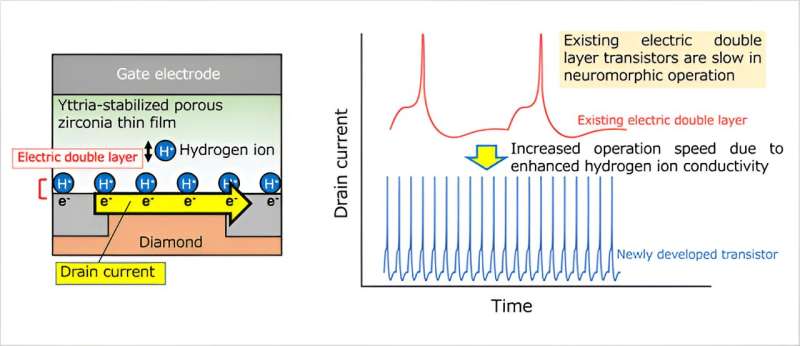This article has been reviewed according to Science X's editorial process and policies. Editors have highlighted the following attributes while ensuring the content's credibility:
fact-checked
trusted source
proofread
Research team develops the fastest neuromorphic, electric double layer transistor

A research team consisting of the National Institute for Materials Science (NIMS) and the Tokyo University of Science has developed the fastest electric double layer transistor using a highly ion-conductive ceramic thin film and a diamond thin film.
This transistor may be used to develop energy-efficient, high-speed edge AI devices with a wide range of applications, including future event prediction and pattern recognition/determination in images (including facial recognition), voices and odors. This research was published in the June 16, 2023, issue of Materials Today Advances.
An electric double layer transistor works as a switch using electrical resistance changes caused by the charge and discharge of an electric double layer formed at the interface between the electrolyte and semiconductor. Because this transistor is able to mimic the electrical response of human cerebral neurons (i.e., acting as a neuromorphic transistor), its use in AI devices is potentially promising.
However, existing electric double layer transistors are slow in switching between on and off states. The typical transition time ranges from several hundreds of microseconds to 10 milliseconds. Development of faster electric double layer transistors is therefore desirable.
This research team developed an electric double layer transistor by depositing ceramic (yttria-stabilized porous zirconia thin film) and diamond thin films with a high degree of precision using a pulsed laser, forming an electric double layer at the ceramic/diamond interface.
The zirconia thin film is able to adsorb large amounts of water into its nanopores and allow hydrogen ions from the water to readily migrate through it, enabling the electric double layer to be rapidly charged and discharged. This electric double layer effect enables the transistor to operate very quickly.
The team actually measured the speed at which the transistor operates by applying pulsed voltage to it and found that it operates 8.5 times faster than existing electric double layer transistors, setting a new world record. The team also confirmed the ability of this transistor to convert input waveforms into many different output waveforms with precision—a prerequisite for transistors to be compatible with neuromorphic AI devices.
This research project produced a new ceramic thin film technology capable of rapidly charging and discharging an electric double layer several nanometers in thickness. This is a major achievement in efforts to create practical, high-speed, energy-efficient AI-assisted devices. These devices, in combination with various sensors (e.g., smart watches, surveillance cameras and audio sensors), are expected to offer useful tools in various industries, including medicine, disaster prevention, manufacturing and security.
More information: Makoto Takayanagi et al, Ultrafast-switching of an all-solid-state electric double layer transistor with a porous yttria-stabilized zirconia proton conductor and the application to neuromorphic computing, Materials Today Advances (2023). DOI: 10.1016/j.mtadv.2023.100393




















